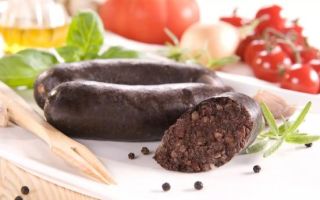Content
- 1 What is blood sausage made of?
- 2 The chemical composition and calorie content of blood sausage
- 3 How is blood sausage useful?
- 4 Can you eat blood sausage
- 5 How to make homemade blood sausage
- 6 The harm of blood sausage and contraindications
- 7 What can you eat blood sausage with
- 8 How to choose and store blood sausage
- 9 Conclusion
The benefits and harms of blood sausage is an important topic related to traditional nutrition and a healthy lifestyle. The traditional Slavic dish, which came from nomadic tribes who dreamed of hunting and consumed the blood of killed game as a protein-rich drink, is now highly regarded for its high nutritional benefits, but it is also associated with prejudice. Let's take a closer look.
What is blood sausage made of?
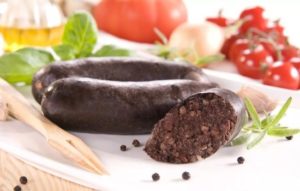
Blood sausage is a dish made from animal blood (mainly pigs), which is peeled and mixed with minced meat and offal: liver, lungs, tongue, pork skins, lard, and spices such as onions, garlic, peppers and marjoram.
The blood for the sausage is pre-cleaned from fibrin (clotted clots) by beating, as well as sterilized against the harm of possible microorganisms. Such purified blood can then be stored and used later by sieving through a sieve before preparation.
The finished product is dark brown in color, which is given by heat-treated blood. That is why the other name for the dish is black pudding. Pork intestines are used as a shell.
The sausage recipe uses cereals to give it a solid structure. Usually buckwheat, pearl barley or barley are suitable for their properties.
The composition of the sausage has a variety of variations, depending on the regions: there are many ways of cooking. For example, in the European tradition, lard is not used for sausage, but bacon may be included as an ingredient, while in Slavic cuisine they prefer blood-pot with fatty properties. However, according to technology, it all comes down to two main options for heat treatment: baking and boiling.
The dish is served both cold and hot.
In Russia, the quality of the product is regulated by GOST R 54670-2011, which, depending on the meat content in the recipe, distinguishes 3 categories of blood sausage according to its properties: "A", "B" and "C". Category "A", as the highest, includes trimmed beef and pork, pork belly, raw food blood, salt and spices.
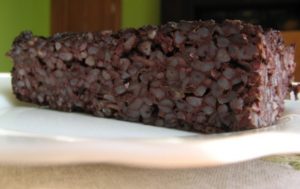
The chemical composition and calorie content of blood sausage
The nutrients, vitamins and minerals contained in blood sausage determine the beneficial properties of this product.
|
Nutrients |
Content |
% Daily requirement |
|
Protein |
14.6 g |
24 |
|
Carbohydrates |
1.29 g |
0 |
|
Fats |
34.5 g |
51 |
|
Polyunsaturated fats |
3.46 g |
16 |
|
Monounsaturated fat |
15.9 g |
72 |
The calorie content of blood sausage per 100 grams of product is 379 kcal, or 19% of the recommended daily allowance.
|
Micro and macro elements |
Content |
% Daily requirement |
|
Sodium, Na |
680 mg |
52 |
|
Cholesterol |
120 mg |
40 |
|
Iron, Fe |
6.4 mg |
36 |
|
Selenium, Se |
15.5 μg |
28 |
|
Zinc, Zn |
1.3 mg |
11 |
Sodium - regulates water-salt metabolism and acid-base balance, the work of the cardiovascular and digestive systems.
Iron - in addition to hemoglobin-forming properties, is involved in the synthesis of thyroid hormones, protects the body from bacteria.
Selenium and Zinc work together to have anti-cancer effects.Selenium is also an antioxidant that stimulates the immune system, promotes the synthesis of thyroid hormones, protection of heart disease and cell growth.
Zinc - regulates blood sugar levels, stimulates the growth and development of the skeleton, is necessary for puberty, protects against infectious diseases.
|
Vitamins |
Content |
% Daily requirement |
|
Vitamin B12, Cobalamin |
1 μg |
33 |
|
Vitamin PP, NE |
4.2 mg |
21 |
|
Vitamin B4, Choline |
72.8 mg |
15 |
|
Vitamin D D2 + D |
31.3 μg |
13 |
|
Vitamin B5, Pantothenic Acid |
0.6 mg |
12 |
Vitamin B12 along with iron is called "antianemic", it has beneficial properties of hematopoiesis.
Vitamin PP - reduces the craving for alcohol, is responsible for protein synthesis, cholesterol regulation, strengthening of the vascular system.
Useful properties of Choline, B4: prevents disorders of the nervous system, improves memory, prevents the formation of stones in the gallbladder, restores damage from toxins from alcohol, drugs, drugs.
Vitamin D helps to strengthen bone tissue, heart function, blood clotting.
Summarizing all the data, we can highlight the main beneficial qualities of blood sausage.
How is blood sausage useful?
6 health benefits that support the occasional inclusion of blood sausage in the diet.
- Ensuring hematopoiesis and prevention of iron deficiency anemia. The main ingredient in sausage - blood - contains a large amount of the protein hemoglobin, which serves as a building material for the formation of red blood cells. At the same time, blood sausage contains heme hemoglobin, which is completely absorbed by the body. The high content of bivalent iron gives the blood sausage the right to become an alternative to pharmaceutical drugs that increase hemoglobin in the blood.
- Increasing blood clotting, which is very important in wound healing. This is provided by the fibrinogen protein, which is part of the blood.
- "Anti-cancer" effect: due to antioxidant properties and optimization of metabolism, bloodworm is indicated during chemotherapy.
- Normalization of the nervous system. A complex of B vitamins is responsible for this.
- Regulation of metabolism and synthesis of hormones. Selenium and vitamin B5 help stabilize the thyroid and adrenal cortex, and the high protein content is a rich source of energy.
- The benefits of the spices included in the cooking technology are to stimulate the digestive tract and normalize metabolic processes, as well as help in cleaning blood vessels.
Can you eat blood sausage
Consider cases where the benefits of eating blood sausage, comparable to taking medications, may be contraindicated. It is worth paying special attention to some of them.
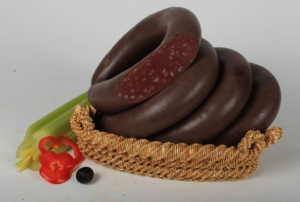
During pregnancy
During pregnancy, a woman's body needs increased doses of all vital elements. Therefore, blood sausage can be periodically used as a healthy source rich in vitamins and minerals. This becomes especially important when maintaining the normal level of hemoglobin, which, due to intensive metabolic processes during pregnancy, can "jump" during gestation. It is difficult to overestimate the benefits of bloody.
At the same time, it is worth emphasizing the importance of adhering to safety rules when choosing a quality product, in order to avoid infection with parasites.
Nursing mom
The benefits of the entire complex of chemical elements contained in blood sausage are very important in the postpartum period, when such a mineral and vitamin bomb can become an invaluable helper during breastfeeding.
The valuable properties of blood sausage will support metabolism and increase the number of red blood cells.
However, the mother needs to introduce it into the diet after consulting a pediatrician and not earlier than the third month from the start of feeding, while carefully monitoring the reaction of her body and her baby. It is helpful to keep track of portion sizes and calculate the protein, fat and carbohydrate content of your daily menu.
With diabetes
Despite the presence in the composition of niacin (vitamin PP), which is used to treat type 2 diabetes, blood sausage still belongs to the potentially harmful heavy fatty foods that are contraindicated in any form of this disease.
The controversy lies in the fact that saturated fatty acids, which are so abundant in blood sausage, are one of the risk factors for diabetes. In addition, their property of impairing vascular permeability makes blood sausage a prohibited product for diabetics.
With gout
Since dietary recommendations for gout are reduced to a diet high in saturated fat and cholesterol, blood sausage becomes a risk factor for exacerbation of the disease. The sausage contains by-products, a large amount of purines in the content of which leads to the formation of uric acid, the increased content of which in the blood and subsequently causes attacks of the disease.
The content of purines and uric acid in 100 g of blood sausage is relatively low: 38 and 90 mg, respectively, at a daily rate of 700-1000 mg, however, the combination of the entire complex of risk factors imposes restrictions on the use of sausage: nutritionists recommend that it be included in the menu carefully, taking into account the possible harm and consultation with a doctor.
How to make homemade blood sausage
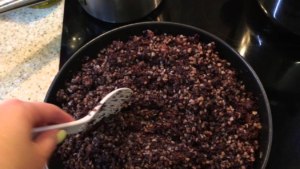
Classic blood sausage with buckwheat:
For cooking you will need:
- buckwheat groats - 300g;
- pork - 300 g;
- lard (brisket) - 300 g;
- pork blood 1 -1.5 l;
- salt, allspice, cloves, caraway seeds - to taste.
Procedure.
- Meat is boiled, bacon (bacon) is poured over with boiling water. Then everything is cut into small pieces.
- Buckwheat is washed and porridge is boiled, left to cool.
- All boiled ingredients are mixed, spices, salt are added, poured over with blood and mixed well until smooth.
- The intestine is washed, tied well on one side and filled with prepared minced meat, smoothing with your hands to evenly fill and push out excess air. The procedure should be performed carefully, filling tightly, but so as not to tear the intestine.
- The rest of the intestine is tied, and then boiled for up to 20 minutes. Then the sausage is dipped in cool water, allowed to drain and cool.
The harm of blood sausage and contraindications
Black pudding is contraindicated:
- with obesity: the calorie content of the product and a large amount of protein in case of overdose or improper metabolism is converted by the liver into fat and deposited in reserve;
- if a person is at risk of diabetic diseases;
- with liver problems: a large amount of fat in the composition can provoke an exacerbation of the disease;
- with symptoms of gastrointestinal diseases: blood sausage is a heavy food for the stomach, which must be eaten with great care;
- with a tendency to thrombosis: a large amount of blood sausage makes the blood viscous, which means that it threatens to cause clogging of blood vessels;
- with individual intolerance.
And general precautions relate to:
- short shelf life, exceeding which is fraught with severe food poisoning;
- violations of cooking technology, the use of stale ingredients or the blood of unhealthy animals threatens to become infected with parasites, for example, Listeria monocytogenes, which travels with the bloodstream and accumulates in the liver and spleen.
What can you eat blood sausage with
Black pudding, like other types of sausages, is actively used as an ingredient in the preparation of many delicacies.
The fastest and most common additions to blood sausage are vegetables and eggs, such as stewed or grilled.
You can also fantasize with a side dish. For example, there is an option to serve blood sausage in German restaurants with a side dish of airy mashed potatoes, fried crispy onions and apple wedges stewed in lemon and sugar.
You can stuff pancakes, pies, tartlets with sauce with bloodwort (it will perfectly set off the taste of apple or other fruit, with sourness, option).

The main thing is not to be afraid to experiment!
How to choose and store blood sausage
The distrust of blood sausage among consumers is due, among other things, to its very limited shelf life (in the refrigerator at a temperature of 0-8 aboutC - two days for smoked and 12 hours for boiled sausage). For this reason, when purchasing, it is important to check the date of manufacture first. The long shelf life indicated by the manufacturer on the package will indicate the use of preservatives in its preparation.
When buying ready-made sausage on the market, you need to take into account its appearance and smell. The cut of the sausage should be uniform in structure, brown, dull (and not watery), without blood spots and reddish tone. The intestinal membrane should fit tightly to the contents. Fresh bloodworm will smell pleasantly and softly with spices, without the trail of intestinal odor.
It is better not to buy cheap varieties in the store, since this way manufacturers save money at the expense of ingredients with inclusions of connective tissue, skins, cartilage.
If all the blood has not been used, storage of leftovers for subsequent preparation is possible only in the freezer.
Conclusion
The benefits and harms of blood sausage is a question, the solution of which depends on the individual capabilities of the body to take advantage of a whole range of useful properties that a unique product contains. What will outweigh the scales - benefit or harm - will depend on individual indications for human health, as well as on compliance with safety rules when choosing a product.

